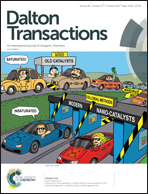Electronic and molecular structure relations in diiron compounds mimicking the [FeFe]-hydrogenase active site studied by X-ray spectroscopy and quantum chemistry†
Abstract
Synthetic diiron compounds of the general formula Fe2(μ-S2R)(CO)n(L)6−n (R = alkyl or aromatic groups; L = CN− or phosphines) are versatile models for the active-site cofactor of hydrogen turnover in [FeFe]-hydrogenases. A series of 18 diiron compounds, containing mostly a dithiolate bridge and terminal ligands of increasing complexity, was characterized by X-ray absorption and emission spectroscopy in combination with density functional theory. Fe K-edge absorption and Kβ main-line emission spectra revealed the varying geometry and the low-spin state of the Fe(I) centers. Good agreement between experimental and calculated core-to-valence-excitation absorption and radiative valence-to-core-decay emission spectra revealed correlations between spectroscopic and structural features and provided access to the electronic configuration. Four main effects on the diiron core were identified, which were preferentially related to variation either of the dithiolate or of the terminal ligands. Alteration of the dithiolate bridge affected mainly the Fe–Fe bond strength, while more potent donor substitution and ligand field asymmetrization changed the metal charge and valence level localization. In contrast, cyanide ligation altered all relevant properties and, in particular, the frontier molecular orbital energies of the diiron core. Mutual benchmarking of experimental and theoretical parameters provides guidelines to verify the electronic properties of related diiron compounds.
![Graphical abstract: Electronic and molecular structure relations in diiron compounds mimicking the [FeFe]-hydrogenase active site studied by X-ray spectroscopy and quantum chemistry](/en/Image/Get?imageInfo.ImageType=GA&imageInfo.ImageIdentifier.ManuscriptID=C7DT02720F&imageInfo.ImageIdentifier.Year=2017)
- This article is part of the themed collection: Dalton Transactions Inorganic Symposia


 Please wait while we load your content...
Please wait while we load your content...